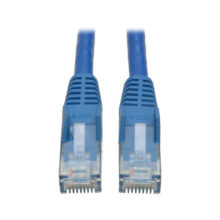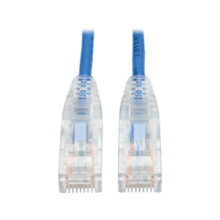What’s the Difference Between 24 AWG, 26 AWG and 28 AWG Network Cables?
When shopping for Cat5e, Cat6 or Cat6a network cables, you may notice an AWG specification printed on the cable jacket, like 24 AWG. The AWG stands for American Wire Gauge, a standardized system for describing the diameter of the individual conductors (wires) that make up a cable. To understand the differences between similar network cables with different AWG sizes, let’s take a look at what wire gauge means.
 AWG and Wire Diameter
AWG and Wire Diameter
The first thing to learn about wire gauge is its inverse relationship to wire diameter. The smaller the gauge, the larger the diameter of the wire. The larger the diameter of a wire, the less electrical resistance there is for the signals it carries. Copper network cables with a smaller gauge (larger diameter) are typically available in longer lengths because they offer less resistance, allowing signals to travel farther. Less resistance also generates less heat. A 24 AWG network cable will offer less resistance than a 26 AWG or 28 AWG network cable.
|
AWG
|
Wire Diameter
|
|
24 Gauge
|
0.0201 inches
|
|
26 Gauge
|
0.0159 inches
|
|
28 Gauge
|
0.0126 inches
|
 Slim Network Cables
Slim Network Cables
In your search for network cable, you may have noticed thin versions of Cat5e, Cat6 and Cat6a cables. Commonly constructed of 28 AWG wire, these slim Ethernet cables can be more than 25% smaller in diameter than their full-size counterparts. The copper conductors have a higher AWG size (remember, a larger gauge means thinner wire), reducing the overall outside diameter (OD) of the cable. The thinner conductors may limit the length of slim cables and make them more prone to damage, but the smaller cable OD can provide some benefits:
· Improved airflow in high-density racks
· Improved visibility of port labels on patch panels and other network equipment
· Easier installation in crowded racks
· Easier routing of cables around corners and through cable managers
Other Factors
Although the gauge of the conductors affects the diameter of an Ethernet cable, the thickness of the cable’s insulation and jacket contribute to its size. There are also other factors to consider when choosing a network cable. The category of cable (Cat5e, Cat6 or Cat6a) you need depends on the connection speed of your network. Additionally, your application may require a shielded cable, a cable rated for outdoor installation or a cable that meets specific building codes.

 Email:info@artseatech.com
Email:info@artseatech.com



 AWG and Wire Diameter
AWG and Wire Diameter Slim Network Cables
Slim Network Cables



 336211
336211